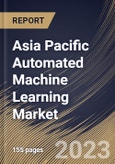The term "Automated Machine Learning" refers to one of the most recent trends in data science. AutoML has been included in most of the top technology businesses' operations to improve the efficacy of their apps. It has altered how companies conduct business, which is why AutoML has been called a "quiet revolution in AI." The solution has altered the field of data science by automating a significant piece of the machine learning procedure. Now that AutoML is being used, businesses of all shapes and sizes have seen a sharp increase in productivity.
Professional data scientists & engineers in short supply in the sector are required to enable AI and machine learning. To meet this need, AutoML automates machine learning's repetitive activities while also increasing the output of the available data scientists. The gap between demand and supply for data scientists, which was increasing, has closed due to the solution. The data scientist can swiftly shift their emphasis to other crucial duties by automating repetitive operations such as picking the data preparation & attribution selection, data sources, and marketing analytics. Furthermore, data scientists can quickly construct more model iterations, improve the quality of existing ones, and create new algorithms due to the automated solution.
Large, complicated datasets, exponentially fast & powerful computers, and machine learning have all contributed to the development of AI. AI's practical and profitable potential is demonstrated by applications like machine learning, wherein the system finds patterns in massive datasets. For example, in China, the government offers improved automated machine learning capabilities for monitoring, social control, or censoring the populace because of AI systems' ability to monitor public areas and analyze internet traffic to ascertain user intent. The Japanese AI industry is anticipated to grow due to the rising global demand for AI, particularly in speech recognition, robotics, and visual recognition. As a result, businesses operating throughout the nation are making significant investments that will help the market in the region grow.
The China market dominated the Asia Pacific Automated Machine Learning Market by Country in 2022 and would continue to be a dominant market till 2029; thereby, achieving a market value of $677.1 million by 2029. The Japan market is exhibiting a CAGR of 43.3% during (2023-2029). Additionally, The India market would showcase a CAGR of 45.1% during (2023-2029).
Based on Application, the market is segmented into Data Processing, Feature Engineering, Model Selection, Hyperparameter Optimization & Tuning, Model Ensembling and Others. Based on Offering, the market is segmented into Solution and Services. Based on Solution Type, the market is segmented into Platform and Software Based on Solution Deployment, the market is segmented into Cloud and On-premise. Based on Vertical, the market is segmented into BFSI, IT & Telecom, Retail & Ecommerce, Media & Entertainment, Healthcare & Life Sciences, Government & Defense, Manufacturing, Automotive, Transportations, & Logistics, and Others. Based on countries, the market is segmented into China, Japan, India, South Korea, Singapore, Malaysia, and Rest of Asia Pacific.
The market research report covers the analysis of key stake holders of the market. Key companies profiled in the report include Oracle Corporation, IBM Corporation, Microsoft Corporation, Google LLC (Alphabet Inc.), Amazon Web Services, Inc. (Amazon.com, Inc.), Salesforce, Inc., Hewlett-Packard enterprise Company, Teradata Corporation, Alibaba Cloud (Alibaba Group Holding Limited) and Databricks, Inc.
Scope of the Study
By Application
- Data Processing
- Feature Engineering
- Model Selection
- Hyperparameter Optimization & Tuning
- Model Ensembling
- Others
By Offering
- Solution
- Type
- Platform
- Software
- Deployment
- Cloud
- On-premise
- Services
- Type
By Vertical
- BFSI
- IT & Telecom
- Retail & Ecommerce
- Media & Entertainment
- Healthcare & Life Sciences
- Government & Defense
- Manufacturing
- Automotive, Transportations, & Logistics
- Others
By Country
- China
- Japan
- India
- South Korea
- Singapore
- Malaysia
- Rest of Asia Pacific
Key Market Players
List of Companies Profiled in the Report:
- Oracle Corporation
- IBM Corporation
- Microsoft Corporation
- Google LLC (Alphabet Inc.)
- Amazon Web Services, Inc. (Amazon.com, Inc.)
- Salesforce, Inc.
- Hewlett-Packard enterprise Company
- Teradata Corporation
- Alibaba Cloud (Alibaba Group Holding Limited)
- Databricks, Inc.
Unique Offerings
- Exhaustive coverage
- The highest number of Market tables and figures
- Subscription-based model available
- Guaranteed best price
- Assured post sales research support with 10% customization free
Table of Contents
Companies Mentioned
- Oracle Corporation
- IBM Corporation
- Microsoft Corporation
- Google LLC (Alphabet Inc.)
- Amazon Web Services, Inc. (Amazon.com, Inc.)
- Salesforce, Inc.
- Hewlett-Packard enterprise Company
- Teradata Corporation
- Alibaba Cloud (Alibaba Group Holding Limited)
- Databricks, Inc.








